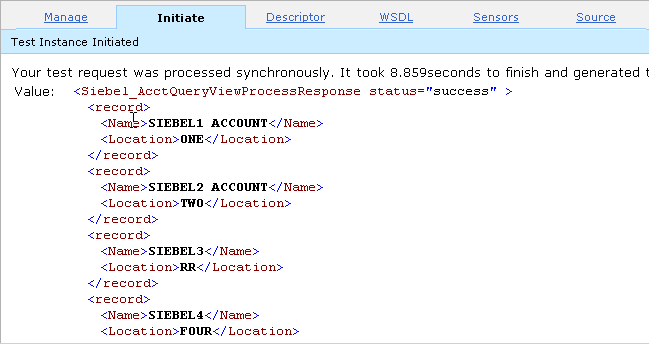|
Oracle® Application Server Adapter for Siebel User's Guide
10g Release 2 (10.1.2) B14062-02 |
|
 Previous |
 Next |
|
Oracle® Application Server Adapter for Siebel User's Guide
10g Release 2 (10.1.2) B14062-02 |
|
 Previous |
 Next |
This chapter contains examples of service and event integration with Siebel.
The service and event scenarios shown depend on the following prerequisites and configuration steps:
Prerequisites
OracleAS Adapter for Siebel installed on the Oracle Application Server.
OracleAS Database adapter deployed and configured.
Oracle BPEL PM Server properly configured and running.
Oracle JDeveloper properly installed.
Configuration Steps
The examples present all the configuration steps necessary for demonstrating service integration with Siebel. The following cross references identify where more information can be obtained.
Create a J2CA configuration, as BPEL PM is only compatible with the J2CA Connector. See "Creating a Configuration for J2CA" for more information
Configure OracleAS Adapter for Siebel for services. See Chapter 2, "Configuring Oracle Application Server Adapter for Siebel" for more information.
See Appendix A, "Using Siebel Workflows" for information on Siebel design requirements.
The following example describes how to add an IO node for Siebel.
Creating an Integration Object Node
Start Application Explorer.

Perform the following steps:
The defined Siebel targets are displayed under the adapter node.
Click the target name, for example, siebel, under the Siebel node.
Verify your connection parameters. If required, provide the password.
Right-click the target name and select Connect.
The x icon disappears, indicating that the node is connected.

Expand the Integration Object node and select Sample Account.

Right-click the Sample Account node and select Add IO Node.
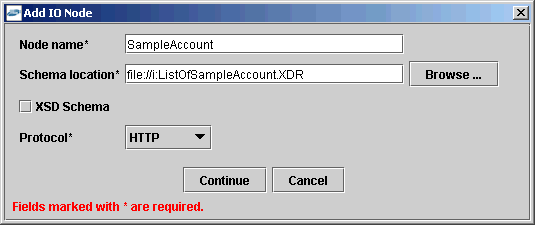
Enter a node name, for example SampleAccount in the Node name field and a path to the Sample Account XDR file in the Schema location field.
Select a protocol from the Protocol list.
This topic illustrates Siebel event integration. The procedures describe design time and runtime.
Creating a Channel
You must create a separate channel for every inbound J2CA service and select that channel when you generate WSDL for inbound interaction using Application Explorer.
|
Note: If more than one inbound service share the same channel, event messages will not be delivered to the right BPEL process. |
In the left pane, click Events.
Expand the Siebel node.
The ports and channels nodes appear in the left pane.

Right-click Channels and select Add Channel.
The Add Channel dialog box is displayed.
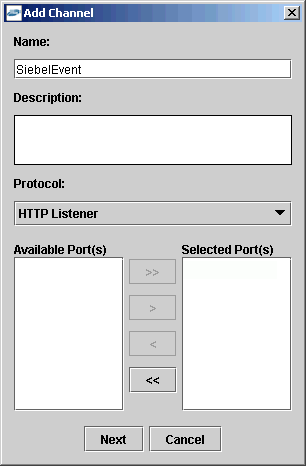
Perform the following steps:
Click Next.
The Basic dialog box is displayed.
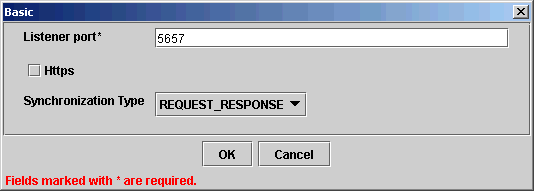
Select REQUEST_RESPONSE from the Synchronization Type drop-down list.
Click OK.
The channel appears under the channels node in the left pane. An X over the icon indicates that the channel is currently disconnected.

Description of the illustration channel_added.gif
Creating an Inbound J2CA Service (Event)
After you create a channel and verify that it is not started, you must first connect to a defined J2CA Siebel target and then create an inbound J2CA service (event) using Application Explorer. See Defining a Target to Siebel for detailed information on how to define a new target.
To connect to a defined target in Application Explorer:
Start Application Explorer.
Expand your J2CA configuration node, and then expand Adapters.
Expand the Siebel node and click the target to which you want to connect.

In the right pane, enter the password for that target.
In the left pane, right-click the target name and select Connect.
The x icon disappears, indicating that the target is connected.
After you connect to a defined target, create an event as follows:
Expand the Integration Object node and right-click SampleAccount.
Select Create Inbound JCA Service (Event).
The Export WSDL dialog box is displayed.
Perform the following steps:
Creating a BPEL PM Server Connection
Before you design a BPEL process, you must create a connection to your BPEL Server using JDeveloper. To create a server connection:
Open JDeveloper.
To display the connections, click the Connections tab at the bottom of the upper left pane in JDeveloper.
The following menu is displayed.
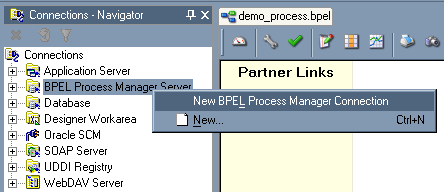
Right-click BPEL Process Manager Server and select New BPEL Process Manager Connection.
The Create BPEL Process Manager Connection - Welcome dialog box is displayed.
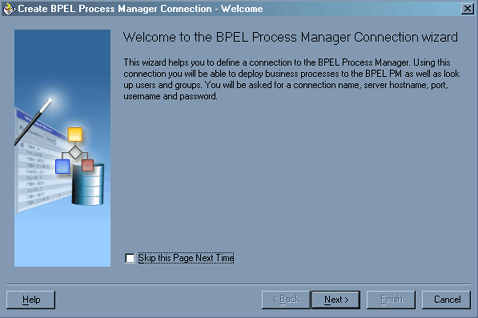
Click Next.
The Create BPEL Process Manager Connection dialog box is displayed.
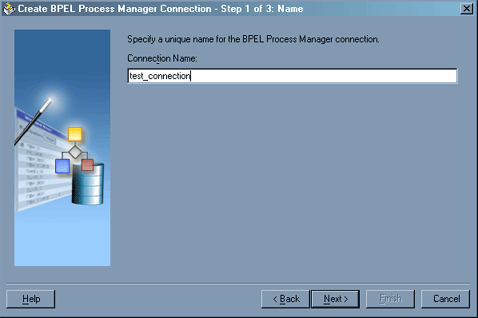
Specify a unique name for your BPEL Server connection and click Next.
Specify a valid host name and port number for the BPEL PM Server you wish to connect to.
Your newly created server connection is displayed in the Connections tab under the BPEL Process Manager Server node.
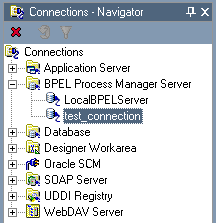
Designing the BPEL Process for the Inbound Service
To design a BPEL process for inbound interaction:
Click the Applications tab and select a workspace for your project.
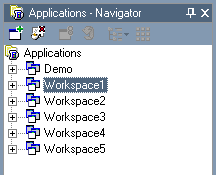
Right-click the workspace and select New Project.
The New Gallery dialog box is displayed.
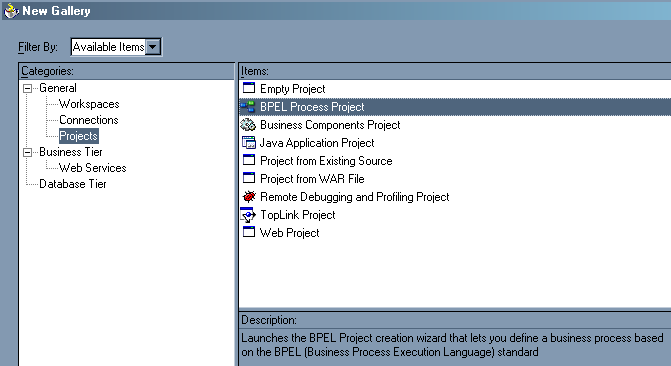
From the Items list, select BPEL Process Project and click OK.
The BPEL Process Project dialog box is displayed.
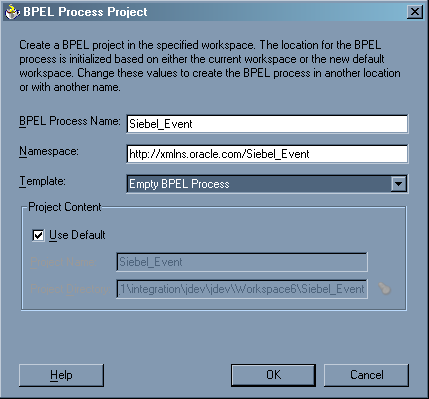
Perform the following steps:
Specify a name for the process, for example, Siebel_Event.
The Namespace field is updated automatically.
From the Template drop-down list, select Empty BPEL Process.
Click OK.
From the Process Activities pane on the right, drag and drop a PartnerLink to the visual editor.
The Create Partner Link dialog box is displayed.
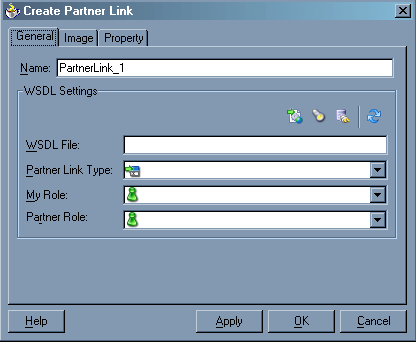
Click the WSIL browser icon (second icon from the left before the WSDL File field).
The WSDL Chooser dialog box is displayed.

Expand your BPEL Server connection, then expand adapters, and then applications.
The WSDL Chooser dialog box is displayed.
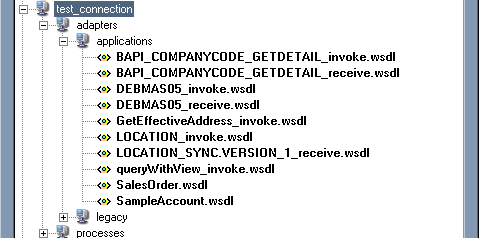
Select SampleAccount.wsdl and click OK.
The Create Partner Link dialog box is displayed.
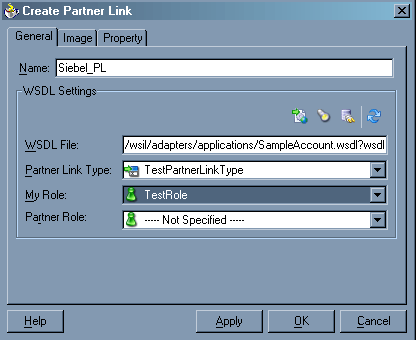
The WSDL File field displays the name and location of the selected WSDL file. The Partner Link Type field specifies the PartnerLink defined in the WSDL file.
Perform the following steps:
From the My Role drop-down list, select the default value TestRole.
Leave the Partner Role field unspecified.
Click Apply, and then OK.
The new Siebel_PL PartnerLink appears in the visual editor.
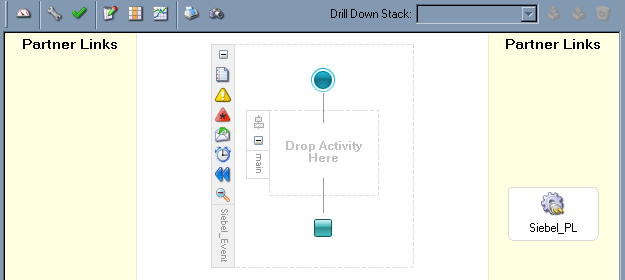
From the Process Activities pane on the right, drag a Receive activity to the visual editor and place it in the designated placeholder labeled Drop Activity Here.
Connect the Receive activity to the Siebel_PL PartnerLink.
The Edit Receive dialog box is displayed.
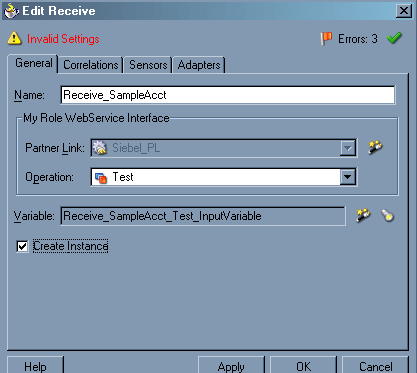
Perform the following steps:
Click Apply.
The Edit Receive dialog box should no longer display any warnings or errors.
Click OK.
Select Save from the File menu.
The completed inbound BPEL process looks as follows:
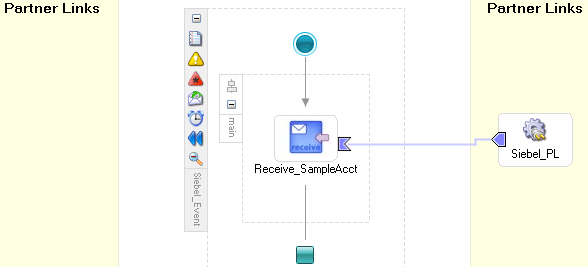
Deploying the BPEL Process for the Inbound Service
Perform the following steps:
Right-click your process flow in the Applications - Navigator pane.
Select Deploy > Your BPEL PM Server connection > Deploy to default domain.
When prompted, enter your BPEL Process Manager password and click OK.
The deployment process starts automatically after you enter the correct password.
Observe the Messages tab at the bottom of the JDeveloper screen.
The following image shows successful deployment.

The following topic describes how to trigger an event in Siebel and verify event integration using OracleAS Adapter for Siebel.
Triggering a Siebel Event to Test Event Runtime Integration
To trigger an event in Siebel:
Start the Siebel Call Center by entering the following URL in a browser:
http://host/callcenter/start.swe
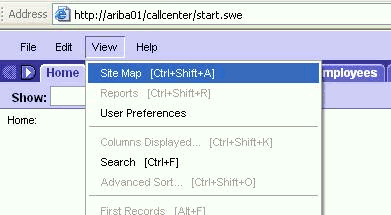
Click View and select Site Map from the list.
The Site Map view is displayed.
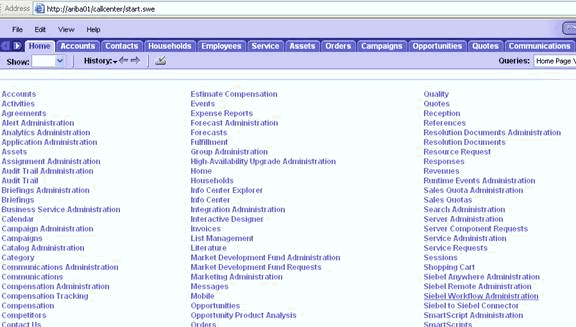
Click Siebel Workflow Administration.
The Siebel Workflow Administration page is displayed.
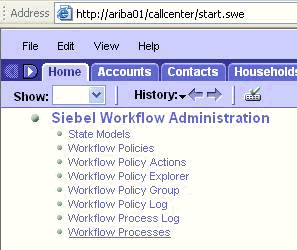
Click Workflow Processes.
The Workflow Processes page is displayed.
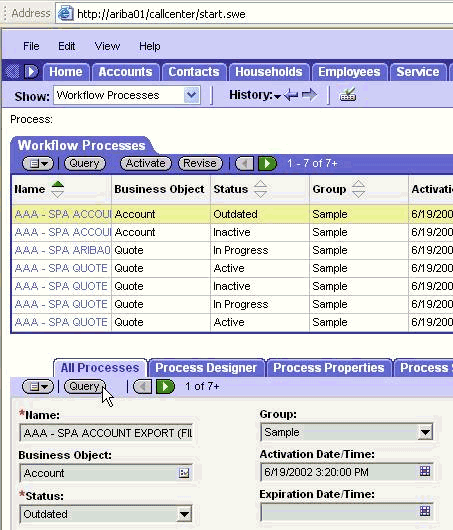
Click Query to search for the Workflow needed to trigger a Siebel event.
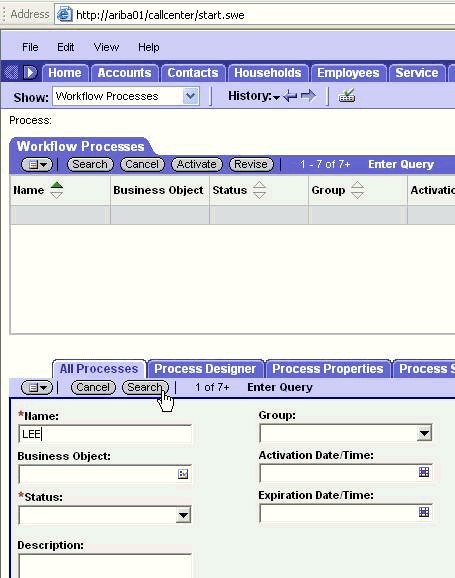
Enter a Siebel workflow name, for example, LEE and click Search.
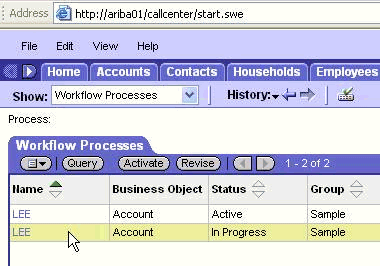
Select the workflow, for example, LEE.
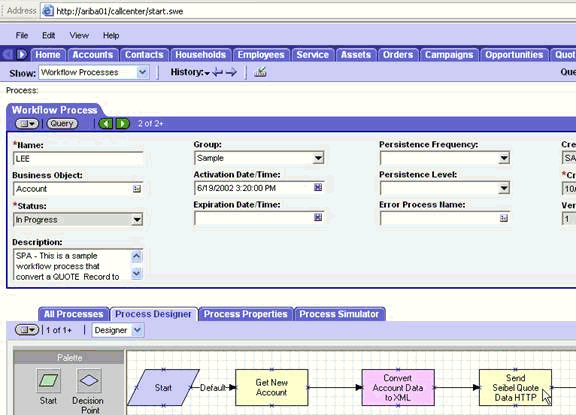
Click the Process Designer tab and double-click the Send Siebel Quote Data HTTP workflow element.
The Input Arguments tab is displayed.
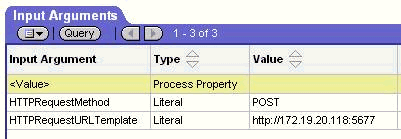
Enter the IP address and port for the HTTPRequestURLTemplate input argument.
Click Return To Designer.
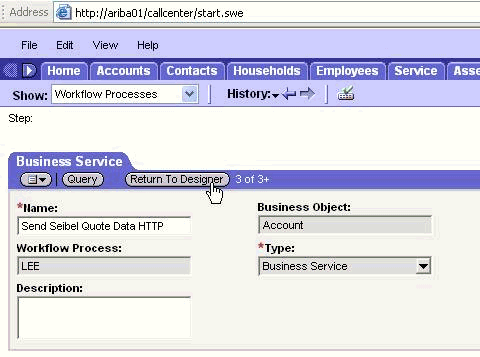
Click the Process Simulator tab.
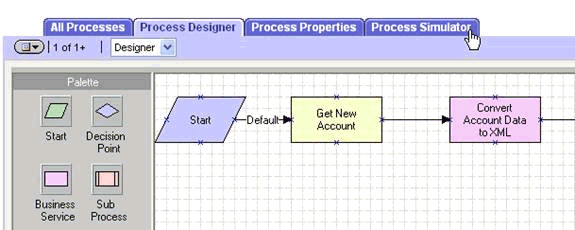
The Simulator tab is displayed.
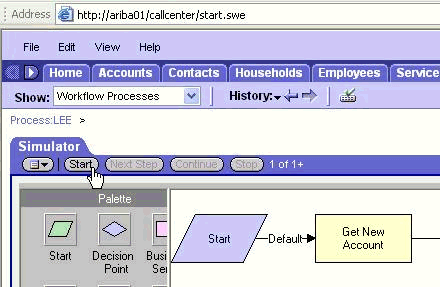
Click Start then Continue to complete the Siebel event triggering process.
Verifying the Results
To verify your results:
Log in to Oracle BPEL Console at
http://host:port/BPELConsole
Enter the password for your BPEL domain.
The default password is bpel.
Click the Instances tab.
Recently received runtime events are displayed in the Instances tab.

Click the Siebel instance, then click Audit to see the event message.
The message received from the Siebel system is displayed in the Audit tab.
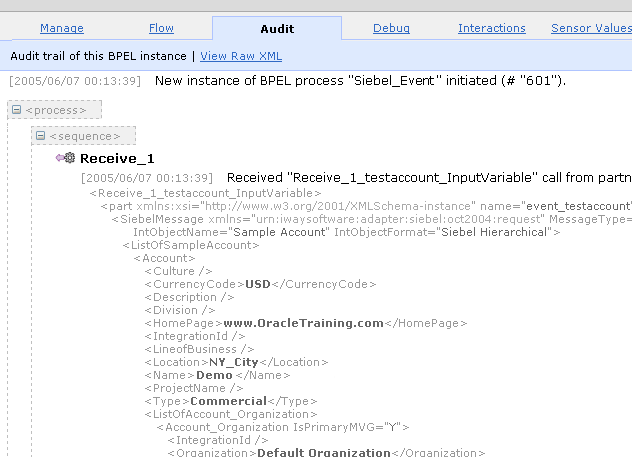
This topic illustrates Siebel service integration. The procedures describe design time and runtime.
Creating a Request-Response J2CA Service in Application Explorer
Before you design a process for Siebel service integration, you must create an outbound J2CA service (WSDL) using Application Explorer.
To generate WSDL in Application Explorer:
Start Application Explorer and connect to a defined Siebel target or create a new target.
See Connecting to a Defined Target for more information.
Expand the Siebel target to which you are connected.
Expand Business Object > Account > Account, navigate to queryWithView, and right-click the object.
The following menu is displayed.
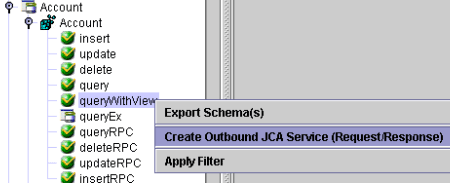
Select Create Outbound JCA Service (Request/Response).
The Export WSDL dialog box is displayed.

Accept the default name and location for the file.
The .wsdl file extension is added automatically.
Click OK.
Creating a BPEL PM Server Connection
Before you design an outbound BPEL process, you must create a connection to your BPEL Server using JDeveloper. See Creating a BPEL PM Server Connection for details on how to create the connection.
Creating a BPEL Project for a Synchronous BPEL Process
To create a BPEL Project for a synchronous BPEL process:
At the bottom of the upper left pane, click the Applications tab and select a workspace for your project.

Right-click the workspace and select New Project.
The New Gallery window is displayed.

From the Items list, select BPEL Process Project and click OK.
The BPEL Process Project dialog box is displayed.
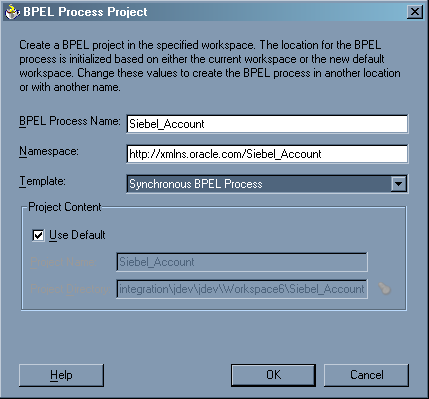
Perform the following steps:
Specify a name for the BPEL process.
The Namespace field is updated automatically.
From the Template drop-down list, select Synchronous BPEL Process.
Designing the BPEL Process for the queryWithView Outbound Service
From the Process Activities pane on the right, drag and drop a PartnerLink to the visual editor.
The Create Partner Link dialog box is displayed.

Click the WSIL browser icon (second icon from the left before the WSDL File field).
The WSDL Chooser dialog box is displayed.

Expand your new server connection, then expand adapters, and then applications.
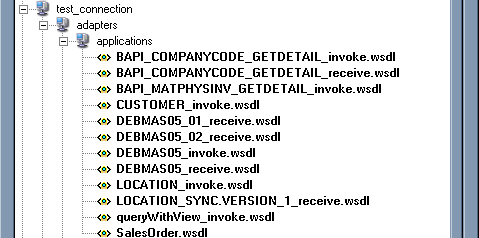
Select queryWithView_invoke.wsdl and click OK.
The WSDL File field in the Create Partner Link dialog box displays the name and location of the selected WSDL file. The Partner Link Type field specifies the PartnerLink defined in the WSDL file.
Perform the following steps:
Leave the My Role field unspecified. The role of the PartnerLink is null, as it will be synchronously invoked from the BPEL process.
From the Partner Role drop-down list, select the default value queryWithViewRole. This is the role of the BPEL process.
Click OK.
Select Save from the File menu.
From the Process Activities pane on the right, drag an Invoke activity to the visual editor and place it between the Receive activity (receiveInput) and the Reply activity (replyOutput).
The Invoke process activity is shown in the diagram view.

Drag the blue arrow from Invoke_1 and connect it to the Siebel PartnerLink.
The Edit Invoke dialog box is displayed.
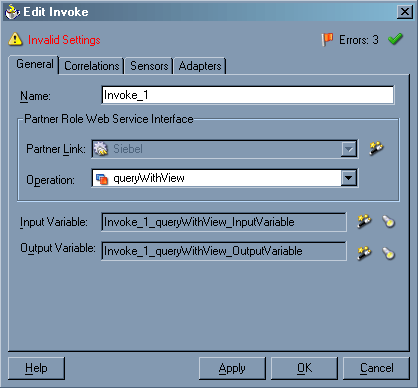
Perform the following steps:
Click the first icon to the right of the Input Variable field, then click OK in the Create Variable window that is displayed.
Repeat the previous step to create a default variable for Output Variable.
Click OK.
Drag an Assign process activity and drop it between the receiveInput Receive activity and Invoke_1 Invoke activity.
The following image shows the new Assign activity in JDeveloper visual editor.
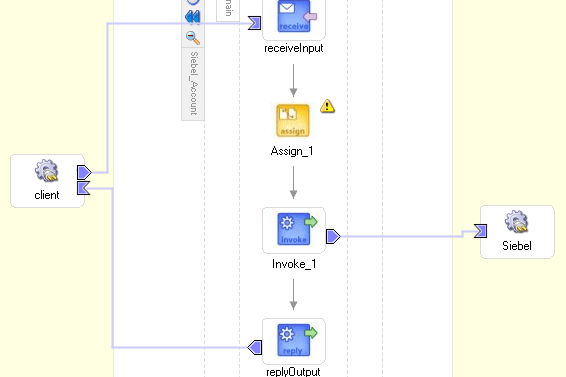
Double-click the Assign activity icon.
The Assign dialog box is displayed.
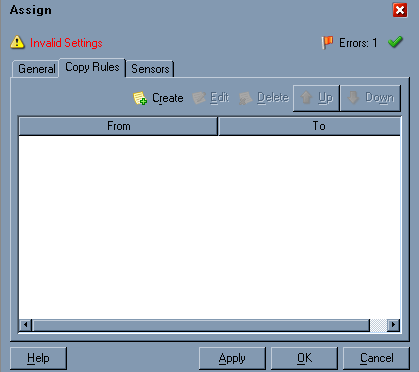
In the Copy Rules tab, click Create.
The Create Copy Rule dialog box is displayed.
Perform the following steps:
In the From pane, expand Variables, then inputVariable, and then highlight payload.
In the To pane, expand Variables, then Invoke_1_queryWithView_InputVariable, and then highlight input_queryWithView.
Your Create Copy Rule dialog box should look as follows:
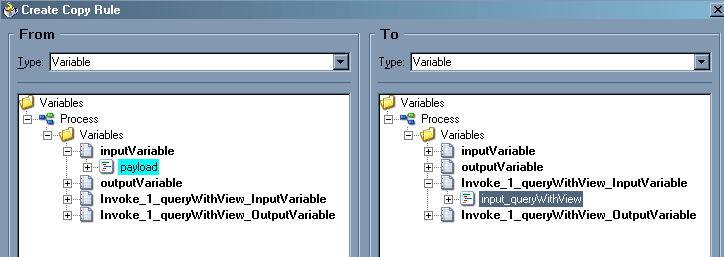
To close the Create Copy Rule dialog box and the Assign dialog box, click OK.
From the Process Activities pane on the right, drag another Assign activity to the visual editor and place it between the Invoke activity (Invoke_1) and the Reply activity (replyOutput).
Double-click the Assign activity icon and click Create.
In the Create Copy Rule dialog box, map Invoke_1_queryWithView_OutputVariable > output_queryWithView to outputVariable > payload.
Verify that you have mapped all variables as follows:
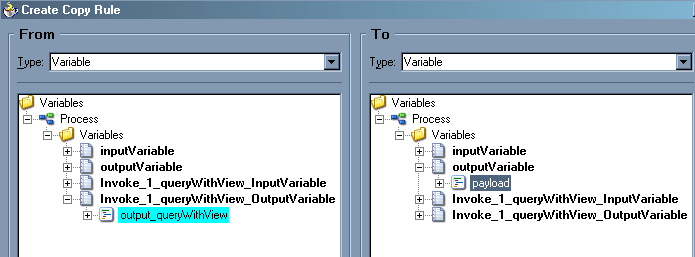
Click OK, then click OK again.
Select Save from the File menu.
You have completed the design of your BPEL process.
Deploying the BPEL Process for the queryWithView Outbound Service
JDeveloper deploys BPEL processes directly to Oracle BPEL Console.
To deploy your BPEL process in JDeveloper:
Right-click your process flow in the Applications - Navigator pane.
Select Deploy > Your BPEL PM Server connection > Deploy to default domain.
The Password Prompt dialog box is displayed.
Enter your BPEL Process Manager password in the Password Prompt dialog box.
The deployment process starts automatically after you enter the correct password.
Observe the Messages log on the bottom of the window.
The Messages log displays the deployment status. In this example, it shows a successful deployment message for the process.

If deployment was not successful, click the Compiler tab to view all error and warning messages generated during the deployment process.
To invoke the queryWithView process from Oracle BPEL Console:
Start Oracle BPEL Console by entering the following URL in a browser:
http://host:port/BPELConsole
Select a domain and provide a valid password.
The Oracle BPEL Console main page is displayed.
The BPEL Processes tab is displayed.
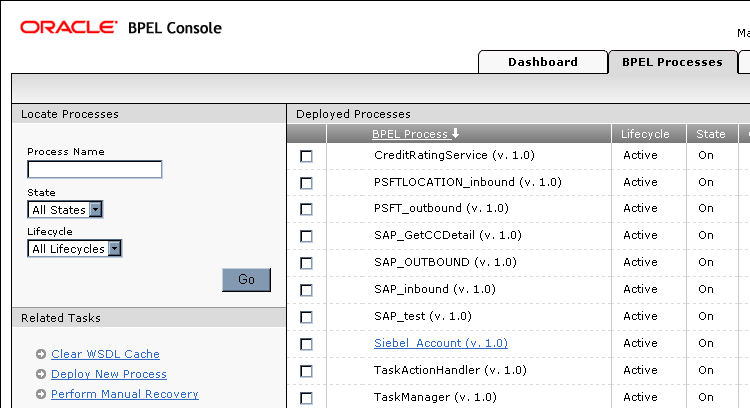
Click the Initiate tab.
The Initiate tab enables you to test your BPEL process.
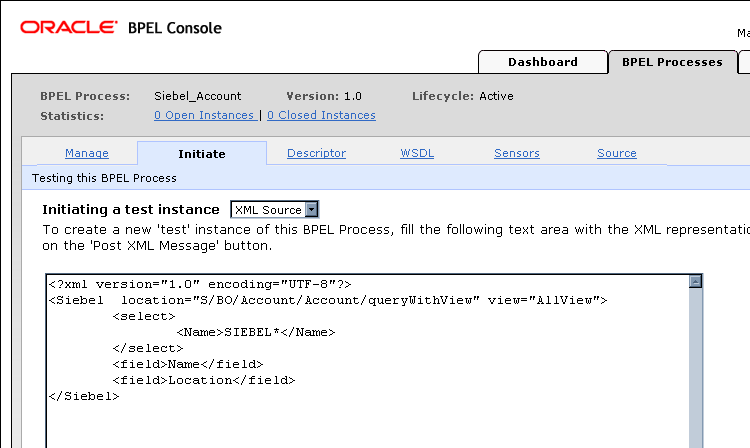
Perform the following steps:
From the Initiating a test instance drop-down menu, select XML Source.
Enter the following code in the text area provided for XML input:
<?xml version="1.0" encoding="UTF-8"?>
<Siebel location="S/BO/Account/Account/queryWithView" view="AllView">
<select>
<Name>SIEBEL*</Name>
</select>
<field>Name</field>
<field>Location</field>
</Siebel>
Click Post XML Message.
The response received from the Siebel system is displayed in the Initiate window.
